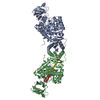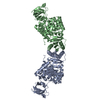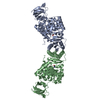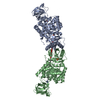+ Open data
Open data
- Basic information
Basic information
| Entry | Database: PDB / ID: 8edr | |||||||||
|---|---|---|---|---|---|---|---|---|---|---|
| Title | E. coli pyruvate kinase (PykF) P70Q | |||||||||
 Components Components | Pyruvate kinase | |||||||||
 Keywords Keywords |  TRANSFERASE / TRANSFERASE /  Pyruvate kinase / Long term evolution experiment / Pyruvate kinase / Long term evolution experiment /  Kinase Kinase | |||||||||
| Function / homology |  Function and homology information Function and homology information pyruvate kinase / pyruvate kinase /  pyruvate kinase activity / pyruvate kinase activity /  potassium ion binding / potassium ion binding /  kinase activity / kinase activity /  phosphorylation / magnesium ion binding / phosphorylation / magnesium ion binding /  ATP binding ATP bindingSimilarity search - Function | |||||||||
| Biological species |   Escherichia coli (E. coli) Escherichia coli (E. coli) | |||||||||
| Method |  X-RAY DIFFRACTION / X-RAY DIFFRACTION /  SYNCHROTRON / SYNCHROTRON /  MOLECULAR REPLACEMENT / Resolution: 2.64 Å MOLECULAR REPLACEMENT / Resolution: 2.64 Å | |||||||||
 Authors Authors | Donovan, K.A. / Coombes, D. / Dobson, R.C.J. / Cooper, T.F. | |||||||||
| Funding support |  United States, 2items United States, 2items
| |||||||||
 Citation Citation |  Journal: To Be Published Journal: To Be PublishedTitle: Beneficial mutations occurring in E. coli pyruvate kinase afford new allosteric mechanisms leading to faster resumption of growth Authors: Donovan, K.A. / Coombes, D. / Dobson, R.C.J. / Cooper, T.F. | |||||||||
| History |
|
- Structure visualization
Structure visualization
| Structure viewer | Molecule:  Molmil Molmil Jmol/JSmol Jmol/JSmol |
|---|
- Downloads & links
Downloads & links
- Download
Download
| PDBx/mmCIF format |  8edr.cif.gz 8edr.cif.gz | 333.3 KB | Display |  PDBx/mmCIF format PDBx/mmCIF format |
|---|---|---|---|---|
| PDB format |  pdb8edr.ent.gz pdb8edr.ent.gz | 273.6 KB | Display |  PDB format PDB format |
| PDBx/mmJSON format |  8edr.json.gz 8edr.json.gz | Tree view |  PDBx/mmJSON format PDBx/mmJSON format | |
| Others |  Other downloads Other downloads |
-Validation report
| Arichive directory |  https://data.pdbj.org/pub/pdb/validation_reports/ed/8edr https://data.pdbj.org/pub/pdb/validation_reports/ed/8edr ftp://data.pdbj.org/pub/pdb/validation_reports/ed/8edr ftp://data.pdbj.org/pub/pdb/validation_reports/ed/8edr | HTTPS FTP |
|---|
-Related structure data
| Related structure data |  8edqC  8edsC  8edtC  8eq0C  8eq1C  8eq3C  8eu4C  4yngS S: Starting model for refinement C: citing same article ( |
|---|---|
| Similar structure data | Similarity search - Function & homology  F&H Search F&H Search |
- Links
Links
- Assembly
Assembly
| Deposited unit | 
| ||||||||
|---|---|---|---|---|---|---|---|---|---|
| 1 | 
| ||||||||
| Unit cell |
|
- Components
Components
| #1: Protein |  Mass: 50823.340 Da / Num. of mol.: 2 / Mutation: P70Q Source method: isolated from a genetically manipulated source Source: (gene. exp.)   Escherichia coli (E. coli) / Gene: pykF / Production host: Escherichia coli (E. coli) / Gene: pykF / Production host:   Escherichia coli BL21(DE3) (bacteria) / References: UniProt: Q2TL68, Escherichia coli BL21(DE3) (bacteria) / References: UniProt: Q2TL68,  pyruvate kinase pyruvate kinase#2: Chemical |  Sulfate Sulfate#3: Water | ChemComp-HOH / |  Water WaterHas ligand of interest | N | |
|---|
-Experimental details
-Experiment
| Experiment | Method:  X-RAY DIFFRACTION / Number of used crystals: 1 X-RAY DIFFRACTION / Number of used crystals: 1 |
|---|
- Sample preparation
Sample preparation
| Crystal | Density Matthews: 2.93 Å3/Da / Density % sol: 57.98 % |
|---|---|
Crystal grow | Temperature: 293 K / Method: vapor diffusion, sitting drop Details: 0.12M (0.3M Diethylene glycol; 0.3M Triethylene glycol; 0.3M Tetraethylene glycol; 0.3M Pentaethylene glycol), 0.1M (1.0M Imidazole; MES monohydrate (acid)), 30% v/v (40% v/v Ethylene glycol; 20 % w/v PEG 8000) |
-Data collection
| Diffraction | Mean temperature: 110 K / Serial crystal experiment: N |
|---|---|
| Diffraction source | Source:  SYNCHROTRON / Site: SYNCHROTRON / Site:  Australian Synchrotron Australian Synchrotron  / Beamline: MX1 / Wavelength: 0.9537 Å / Beamline: MX1 / Wavelength: 0.9537 Å |
| Detector | Type: ADSC QUANTUM 210r / Detector: CCD / Date: Oct 25, 2013 |
| Radiation | Protocol: SINGLE WAVELENGTH / Monochromatic (M) / Laue (L): M / Scattering type: x-ray |
| Radiation wavelength | Wavelength : 0.9537 Å / Relative weight: 1 : 0.9537 Å / Relative weight: 1 |
| Reflection | Resolution: 2.64→41.83 Å / Num. obs: 33761 / % possible obs: 94.8 % / Redundancy: 1.9 % / CC1/2: 0.998 / Rmerge(I) obs: 0.03724 / Net I/σ(I): 19.78 |
| Reflection shell | Resolution: 2.64→2.734 Å / Rmerge(I) obs: 0.3222 / Mean I/σ(I) obs: 2.42 / Num. unique obs: 2381 / CC1/2: 0.796 |
- Processing
Processing
| Software |
| ||||||||||||||||||||||||||||||||||||||||||||||||||||||||||||||||||||||||||||||||||||||||||||||||||||||||||||
|---|---|---|---|---|---|---|---|---|---|---|---|---|---|---|---|---|---|---|---|---|---|---|---|---|---|---|---|---|---|---|---|---|---|---|---|---|---|---|---|---|---|---|---|---|---|---|---|---|---|---|---|---|---|---|---|---|---|---|---|---|---|---|---|---|---|---|---|---|---|---|---|---|---|---|---|---|---|---|---|---|---|---|---|---|---|---|---|---|---|---|---|---|---|---|---|---|---|---|---|---|---|---|---|---|---|---|---|---|---|
| Refinement | Method to determine structure : :  MOLECULAR REPLACEMENT MOLECULAR REPLACEMENTStarting model: 4YNG Resolution: 2.64→41.83 Å / SU ML: 0.33 / Cross valid method: THROUGHOUT / σ(F): 1.33 / Phase error: 24.57 / Stereochemistry target values: ML
| ||||||||||||||||||||||||||||||||||||||||||||||||||||||||||||||||||||||||||||||||||||||||||||||||||||||||||||
| Solvent computation | Shrinkage radii: 0.9 Å / VDW probe radii: 1.11 Å / Solvent model: FLAT BULK SOLVENT MODEL | ||||||||||||||||||||||||||||||||||||||||||||||||||||||||||||||||||||||||||||||||||||||||||||||||||||||||||||
| Displacement parameters | Biso max: 168.68 Å2 / Biso mean: 37.1334 Å2 / Biso min: 10.67 Å2 | ||||||||||||||||||||||||||||||||||||||||||||||||||||||||||||||||||||||||||||||||||||||||||||||||||||||||||||
| Refinement step | Cycle: final / Resolution: 2.64→41.83 Å
| ||||||||||||||||||||||||||||||||||||||||||||||||||||||||||||||||||||||||||||||||||||||||||||||||||||||||||||
| LS refinement shell | Refine-ID: X-RAY DIFFRACTION / Rfactor Rfree error: 0
|
 Movie
Movie Controller
Controller



 PDBj
PDBj



